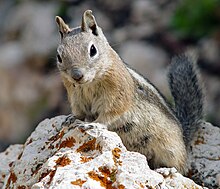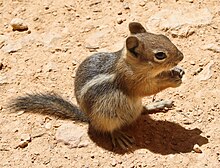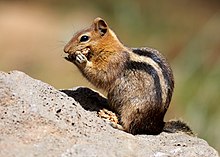Golden-mantled ground squirrel
| Golden-mantled ground squirrel | |
|---|---|
 | |
Conservation status | |
| Scientific classification | |
| Domain: | Eukaryota |
| Kingdom: | Animalia |
| Phylum: | Chordata |
| Class: | Mammalia |
| Order: | Rodentia |
| Family: | Sciuridae |
| Genus: | Callospermophilus |
| Species: | C. lateralis |
| Binomial name | |
| Callospermophilus lateralis (Say, 1823) | |
 | |
| Synonyms | |
| Spermophilus lateralis | |
The golden-mantled ground squirrel (Callospermophilus lateralis) is a ground squirrel native to western North America. It is distributed in the Rocky Mountains of British Columbia and Alberta, and through much of the western United States.[1]
Description
This ground squirrel is generally about 23 to 29 cm (9.1 to 11.4 in) in length. The weight range for adults is between 120 and 394 grams (0.26 to 0.86 lbs.)[citation needed] It has whitish or yellow-gray underparts. The tail is brown to black with buff edges and a yellowish to reddish underside. It has pale rings around the eyes. The "mantle" across the shoulders is tawny to reddish, with males having a deeper reddish tinge. This species is distinguished from similar ground squirrels by a black-bordered white stripe down each side of the back and is distinguished from similar looking chipmunks by its lack of facial stripes.[2]
Some authors describe many subspecies of this taxon.[3]
Biology and ecology

This species occurs in forests, chaparral, meadow margins, and sagebrush, especially in areas with many rocks or forest litter that provides shelter. It is associated with many kinds of coniferous trees, aspen, and manzanita.[2]
It is omnivorous, feeding on pine nuts, acorns, herbs and shrubs, fungi, many kinds of insects, eggs, young birds, lizards, carrion, and human foods when available.[2] This species caches food near its burrow, especially during the late summer and fall.[2] The squirrel has also been known to "beg" for human food at the wildlife urban interface.[4]

This species hibernates over the winter. During the summers they gain extra weight in order to prepare for hibernation.[4] The squirrels hibernate in dens that can reach up to 100 feet in length although they are typically shallow in depth.[5] The breeding season commences when males and females emerge from hibernation in the spring. Most broods are born in July. A female has two to eight young per litter, with an average of five. There is no paternal care of the offspring. Juveniles resemble adults by 40 days of age. The life span of this ground squirrel is up to about seven years.[2]

Most adults are independent, rarely cooperating, and usually competing for resources. They may assemble at sites with abundant food but develop a group hierarchy. Adults reside alone in burrows, creating nests for hibernation or rearing of young. This species has been known to nest in structures, such as roofs.[2] This species becomes vocal when it feels threatened, making squeaking noises or growling. However, it is generally not a very vocal species.[4]
Predators of this squirrel include snakes, foxes, weasels, and bears.[1] It may carry the Rocky Mountain wood tick, a vector of Rocky Mountain spotted fever and other diseases.[1]
Conservation
This is a common and widespread species that is not considered to be threatened.[1]
References
- ^ a b c d e Cassola, F. (2016). "Callospermophilus lateralis". IUCN Red List of Threatened Species. 2016: e.T42468A22265474. doi:10.2305/IUCN.UK.2016-3.RLTS.T42468A22265474.en. Retrieved 19 February 2022.
- ^ a b c d e f Bartels, M. A. and D. P. Thompson. Spermophilus lateralis. Archived 2007-07-11 at the Wayback Machine In: Wilson, D. E. & D. M. Reeder (Eds). 2005. Mammal Species of the World. A Taxonomic and Geographic Reference (3rd ed.), Johns Hopkins University Press.
- ^ Callospermophilus lateralis. Integrated Taxonomic Information System (ITIS).
- ^ a b c Evans, Adare (November 2016). "Golden-Mantled Ground Squirrel" (PDF). Wildlife Express (Idaho Fish and Game). 30.
- ^ Fraley, John (2018). "Golden-Mantled Ground Squirrel". Montana Outdoors.
External links
- NatureServe. 2017. Callospermophilus lateralis. NatureServe Explorer V.7.1 Accessed 6 September 2017.
- Golden-mantled Ground Squirrel. Archived 2012-07-18 at the Wayback Machine North American Mammals. Smithsonian Museum of Natural History.
- v
- t
- e
(antelope squirrels)
- Harris's antelope squirrel (A. harrisii)
- Espíritu Santo antelope squirrel (A. insularis)
- Texas antelope squirrel (A. interpres)
- White-tailed antelope squirrel (A. leucurus)
- San Joaquin antelope squirrel (A. nelsoni)
(golden-mantled ground squirrels)
- Golden-mantled ground squirrel (C. lateralis)
- Sierra Madre ground squirrel (C. madrensis)
- Cascade golden-mantled ground squirrel (C. saturatus)
(prairie dogs)
- Gunnison's prairie dog (C. gunnisoni)
- White-tailed prairie dog (C. leucurus)
- Black-tailed prairie dog (C. ludovicianus)
- Mexican prairie dog (C. mexicanus)
- Utah prairie dog (C. parvidens)
- Siberian chipmunk (E. sibiricus)
(little ground squirrels)
- Mexican ground squirrel (I. mexicanus)
- Rio Grande ground squirrel (I. parvidens)
- Thirteen-lined ground squirrel (I. tridecemlineatus)
(marmots)
- Bobak marmot (M. bobak)
- Alaska marmot (M. broweri)
- Black-capped marmot (M. camtschatica)
- Long-tailed marmot (M. caudata)
- Himalayan marmot (M. himalayana)
- Alpine marmot (M. marmota)
- Menzbier's marmot (M. menzbieri)
- Groundhog or woodchuck (M. monax)
- Tarbagan marmot (M. sibirica)
Subgenus Petromarmota: Hoary marmot (M. caligata) - Yellow-bellied marmot (M. flaviventris)
- Olympic marmot (M. olympus)
- Vancouver Island marmot (M. vancouverensis)
(western chipmunks)
- Tropical ground squirrel (N. adocetus)
- Ring-tailed ground squirrel (N. annulatus)
(rock squirrels)
- Baja California rock squirrel (O. atricapillus)
- California ground squirrel (O. beecheyi)
- Rock squirrel (O. variegatus)
- Franklin's ground squirrel (P. franklinii)
(Asian rock squirrels)
- Père David's rock squirrel (S. davidianus)
- Forrest's rock squirrel (S. forresti)
(Old World ground squirrels)
- Alashan ground squirrel (S. alashanicus)
- Brandt’s ground squirrel (S. brevicauda)
- European ground squirrel (S. citellus)
- Daurian ground squirrel (S. dauricus)
- Red-cheeked ground squirrel (S. erythrogenys)
- Yellow ground squirrel (S. fulvus)
- Russet ground squirrel (S. major)
- Caucasian mountain ground squirrel (S. musicus)
- Tian Shan ground squirrel (S. nilkaensis)
- Pallid ground squirrel (S. pallidicauda)
- Little ground squirrel (S. pygmaeus)
- Relict ground squirrel (S. relictus)
- Speckled ground squirrel (Spermophilus suslicus)
- Taurus ground squirrel (Spermophilus taurensis)
- Asia Minor ground squirrel (Spermophilus xanthoprymnus)
- Eastern chipmunk (T. striatus)
(Holarctic ground squirrels)
- Uinta ground squirrel (U. armatus)
- Belding's ground squirrel (U. beldingi)
- Northern Idaho ground squirrel (U. brunneus)
- Merriam's ground squirrel (U. canus)
- Columbian ground squirrel (U. columbianus)
- Wyoming ground squirrel (U. elegans)
- Southern Idaho ground squirrel (U. endemicus)
- Piute ground squirrel (U. mollis)
- Arctic ground squirrel (U. parryii)
- Richardson's ground squirrel (U. richardsonii)
- Townsend's ground squirrel (U. townsendii)
- Long-tailed ground squirrel (U. undulatus)
- Washington ground squirrel (U. washingtoni)
(pygmy ground squirrels)
- Mohave ground squirrel (X. mohavensis)
- Perote ground squirrel (X. perotensis)
- Spotted ground squirrel (X. spilosoma)
- Round-tailed ground squirrel (X. tereticaudus)













